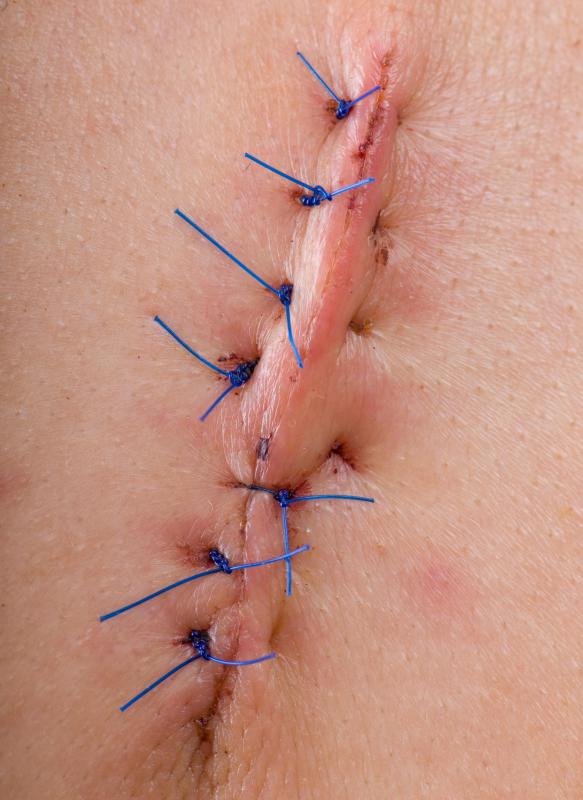At TheHealthBoard, we're committed to delivering accurate, trustworthy information. Our expert-authored content is rigorously fact-checked and sourced from credible authorities. Discover how we uphold the highest standards in providing you with reliable knowledge.
What is a Suture?
The term “suture” is used to refer both to a specific technique for closing a wound, in which the sides of the wound are stitched together, and to the individual stitches involved in the wound closure. More generally, a suture is any type of join, which is why people refer to “sutures” in the skull where the plates of the skull fuse together. These stitches are used in a wide variety of types of medical treatment, ranging from surgery to emergency medicine, and they are typically introduced at an early stage in medical education.
When a wound is stitched, the goal is to close it to promote healing. By closing the wound, the doctor can keep the inside of the wound cleaner, and encourage the edges of the wound to fuse back together during the healing and recovery process. In a case where a wound might need to drain fluids, a drain will be implanted during the stitching stage to allow pus and other materials to flow out of the wound.

The threads used are highly specialized. They cannot wick materials from the outside world into the wound, as this could promote infection, and they must also be very sturdy, as the stitches will need to withstand a great deal of twisting, flexing, and strain. They must also be hypoallergenic, as a patient reaction is highly undesirable. Historically, stitches were made from meticulously cleaned intestines, but modern sutures may be made from various plastic synthetics or even metal, depending on the situation.

Some sutures are absorbable, which means that as the wound heals, the body dissolves the stitching material. Absorbable stitches are commonly used in cases where follow-up may not be strictly necessary, or in internal surgeries, where future removal of the stitches is a practical impossibility. Other sutures are of the nonabsorbable variety, requiring future attention to remove the stitches. Nonabsorbable stitches are often used when a doctor wants to make sure that a patient receives follow-up treatment, since the patient must go to the doctor to get the stitches taken out.

Needles for suturing are curved, and they may come prepackaged with suture material, or sold on their own. Prepackaged needle kits are especially useful in emergency medicine, where doctors may need quick access to stitching materials. Individual needles can be useful in environments where needs are more diverse, allowing a doctor flexibility in selecting the best needle and stitch material for the patient.

Sutures have been used in medical treatment for centuries. The development of sutures probably owes its start to the practice of sewing, with some intrepid doctor realizing that if one could join two pieces of fabric with stitches, the same could be done with skin. In addition to stitches, doctors can also use surgical staples and specialized glue to close wounds, depending on the patient and the condition.
AS FEATURED ON:
AS FEATURED ON:















Discussion Comments
Go to the doctor! I am a qualified naturopath and MD, but without evaluating her circumstances I can't say what is best. See a professional. It's for the best.
my wife's sister has an enormous hernia, and she is a small person, probably about 5 feet 2 inches and when she is sitting the hernia is massive. It accounts for most off her size, it would seem. what can she do about this?
Post your comments